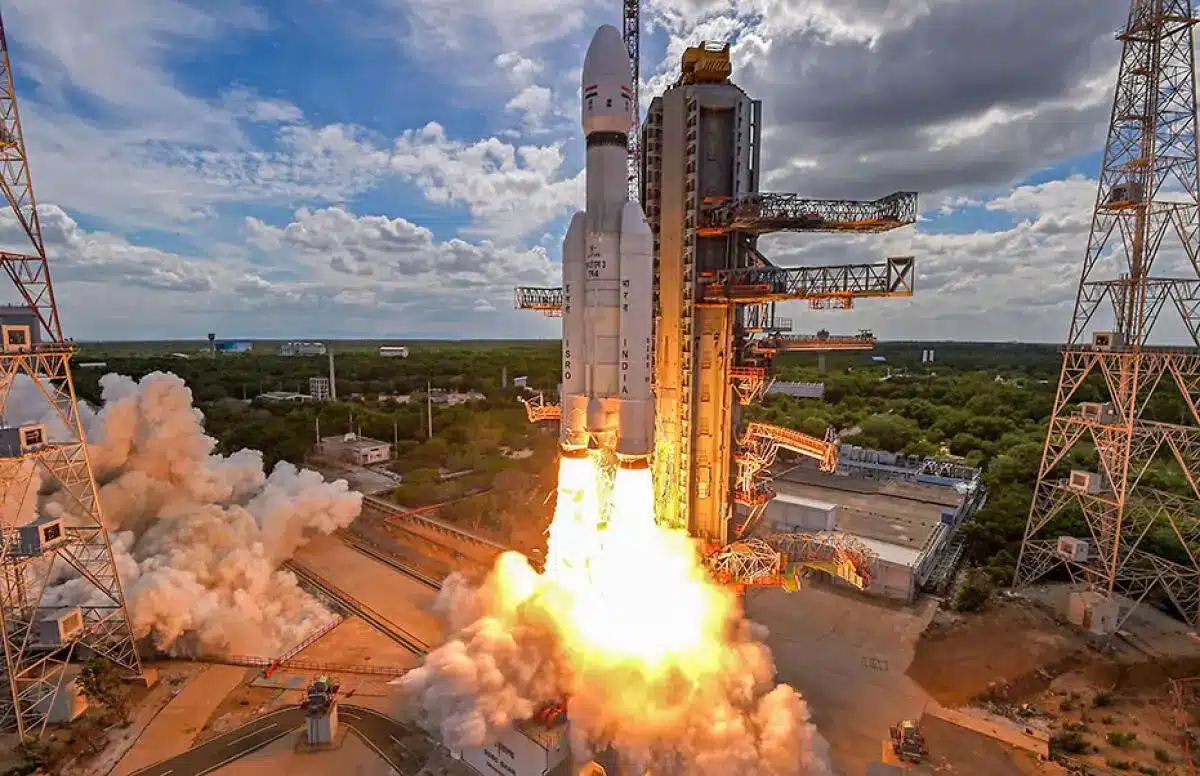What’s in today’s article?
- Why in News?
- Opening up Indian Space Sector for Private Sector
- Indian Regulatory Framework for Private Space Companies
- NSIL Calling Private Players to Manufacture LVM3
Why in News?
- The commercial arm of the department of space (DoS) – New Space India Limited (NSIL), has called on private players to manufacture its largest launch vehicle LVM3.
- This is the same launch vehicle that carried Chandrayaan-2 and Chandrayaan-3 to the moon, and it will also be utilised for the Gaganyaan (human spaceflight) mission.
Opening up Indian Space Sector for Private Sector:
- The DOS desires to encourage the participation of private companies in space activities.
- This is to enhance the diffusion of space technology and boost space economy (from current $8 billion/ 2% of global space economy to $100 billion by 2040) within the country,
- As a result, start-ups began to take root in India in the early 2010s with the first space start-up, Dhruva Space Private Limited, being established in 2012 in Hyderabad.
- Soon after, several other space start-ups cropped up in India: Bellatrix Aerospace (2015), Manastu Space (2017), Skyroot Aerospace (2018), etc.
- As of date, over 200 space start-ups are registered in the country, attracting investments worth ₹1000 crore in 2023 itself.
- Most of these companies are involved in designing and manufacturing satellites, launch vehicles, etc., and offer launch services using ISRO’s PSLV/GSLV or private launch vehicles.
Indian Regulatory Framework for Private Space Companies:
- NewSpace India Limited (NSIL):
- It is a Public Sector Undertaking (PSU) of the Government of India under DoS and is responsible for producing, assembling and integrating the launch vehicle with the help of industry consortium.
- It was established in 2019 under the Company Act 2013, with the main objective to scale up private sector participation in Indian space programmes.
- In 2022, the agency called for complete manufacturing of its workhorse Polar Satellite Launch Vehicle (PSLV).
- A consortium of HAL and L&T has been selected to manufacture five PSLV, with the first flight of the privately manufactured vehicle likely this year.
- Indian National Space Promotion and Authorization Center (IN-SPACe):
- As part of the 4th ‘Aatma Nirbhar Bharat Abhiyan’ stimulus, the Union Finance Minister announced the creation of IN-SPACe in 2020.
- IN-SPACe was set up as a single-window, independent, nodal agency to authorise, promote and supervise space activities of private non-governmental entities (NGEs).
- Since its establishment, IN-SPACe has signed 45 MoUs with NGEs to support them in space activities.
- National Geospatial Policy:
- In 2021, Centre issued guidelines for private companies to acquire all geospatial data and maps from government agencies without licences.
- Building on these guidelines, the Centre also unveiled the National Geospatial Policy in 2022. The policy promotes private sector participation in collection of geospatial data.
- Indian Space Policy:
- Strengthening the private space sector in India by finally providing a legislative framework, the Centre rolled out the Indian Space Policy in 2023.
- The policy has paved the way for ISRO to transition from manufacturing operational space systems to a focus on research and development in advanced technologies.
- Amended FDI policy: In 2024, Centre amended its FDI policy, allowing –
- Up to 74% FDI for satellite manufacturing and operation,
- Up to 49% FDI for launch vehicles, spaceports and associated systems and
- 100% FDI to manufacture components and systems/subsystems for satellites, ground and user segments.
NSIL Calling Private Players to Manufacture LVM3:
- About Launch Vehicle Mark-3 (LVM3):
- The LVM3 (previously GSLV Mk III) is the new heavy lift launch vehicle of ISRO for achieving a 4000 kg spacecraft launching capability to GTO (Geosynchronous Transfer Orbit) in a cost-effective manner.
- LVM3 is a three-stage launch vehicle consisting of two solid propellant S200 strap-ons and core stages comprising of L110 liquid stage and C25 cryogenic stage.
- The commercial capability of the LVM3:
- It was first demonstrated when it was used to deploy multiple satellites in low earth orbit (LEO).
- Two batches of 36 satellites each were launched using the vehicle in 2022 and 2023 commercially for internet provider OneWeb.
- Not only did the vehicle deploy multiple satellites for the first time, it did so in different orbits during the missions.
- Why NSIL Looking Towards Private Players?
- NSIL recognises that there is a growing demand for launching heavier communications satellites as well as other satellites to LEO.
- This is in line with the government’s vision to increase participation of private players, making them capable of manufacturing complete launch vehicles instead of remaining mere producers of parts.
- How will NSIL Handover Projects to Private Players? NSIL will conduct a two-stage bidding process – shortlist multiple technically qualified manufacturers and then select one company based on their financial competitiveness.
Source: NSIL seeks private partners to build its heavy lift rocket LVM3 | ISRO | The Hindu
Last updated on June, 2025
→ UPSC Notification 2025 was released on 22nd January 2025.
→ UPSC Prelims Result 2025 is out now for the CSE held on 25 May 2025.
→ UPSC Prelims Question Paper 2025 and Unofficial Prelims Answer Key 2025 are available now.
→ UPSC Calendar 2026 is released on 15th May, 2025.
→ The UPSC Vacancy 2025 were released 1129, out of which 979 were for UPSC CSE and remaining 150 are for UPSC IFoS.
→ UPSC Mains 2025 will be conducted on 22nd August 2025.
→ UPSC Prelims 2026 will be conducted on 24th May, 2026 & UPSC Mains 2026 will be conducted on 21st August 2026.
→ The UPSC Selection Process is of 3 stages-Prelims, Mains and Interview.
→ UPSC Result 2024 is released with latest UPSC Marksheet 2024. Check Now!
→ UPSC Toppers List 2024 is released now. Shakti Dubey is UPSC AIR 1 2024 Topper.
→ Also check Best IAS Coaching in Delhi






















